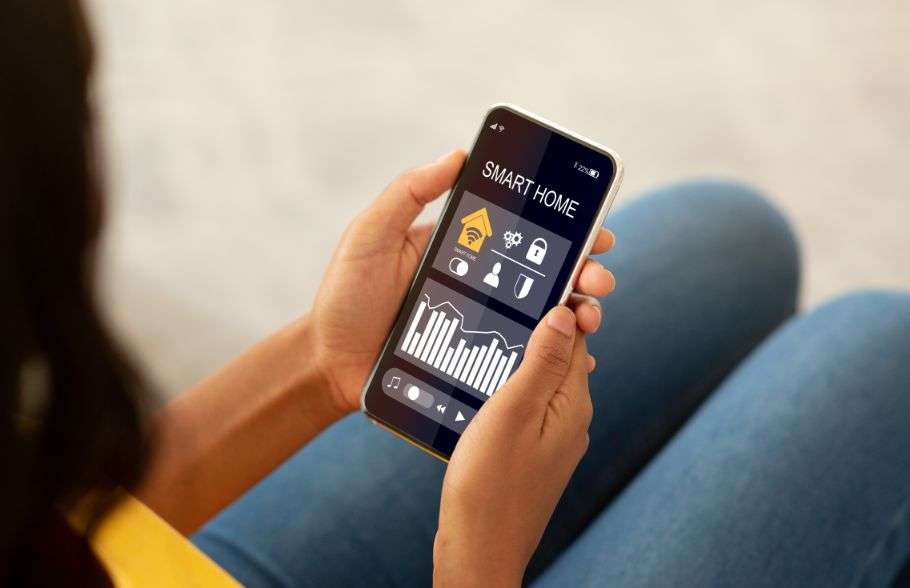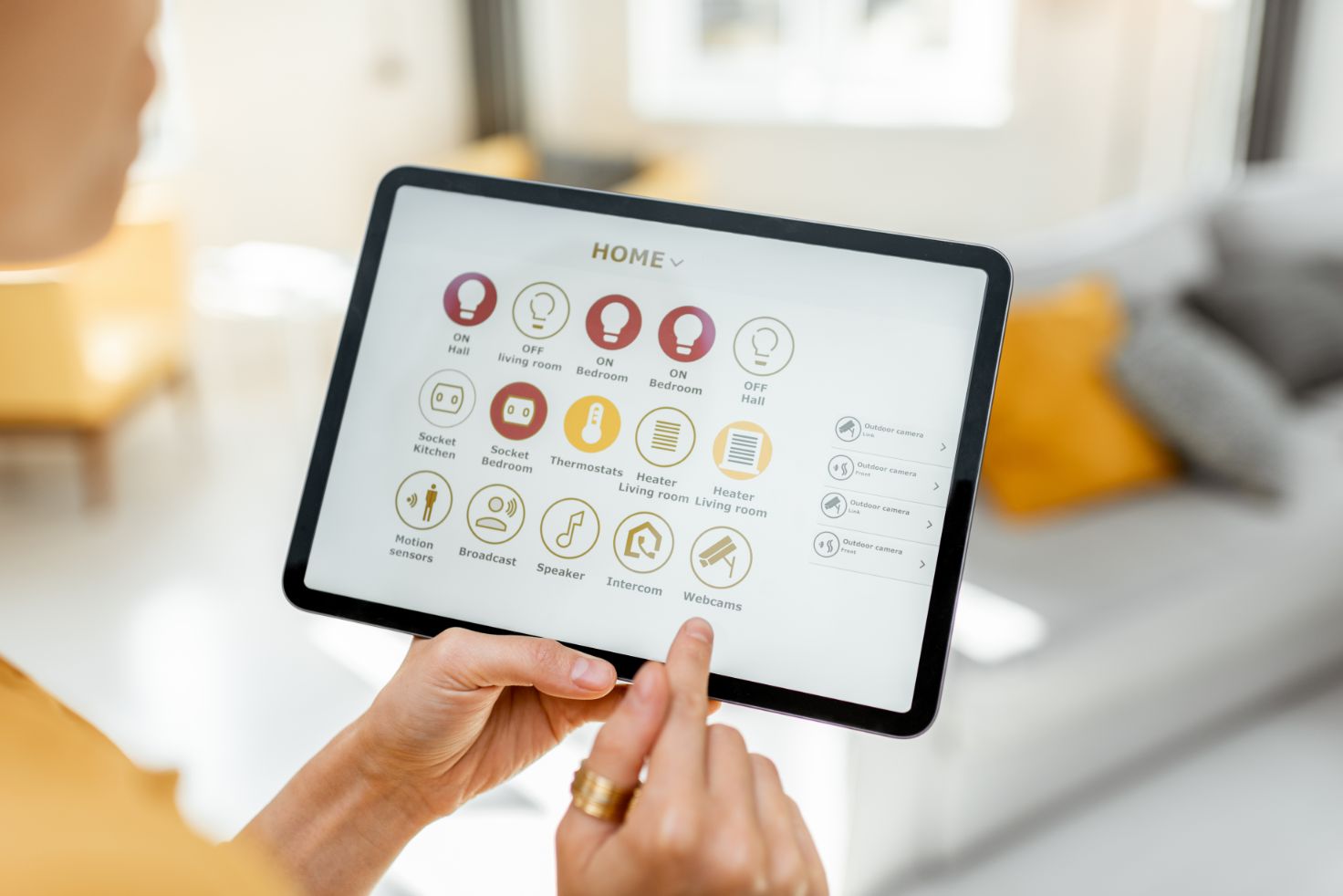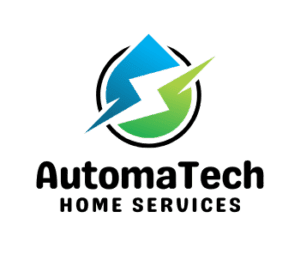How is the Evolution of Smart Home in Modern Living? We’re gonna talk about it from its Early Beginnings to the rapid Rise of the Internet that transformed houses into intelligent havens. As we navigate through the landscape of Connected Ecosystems and experience the magic of Voice Control that brings our homes to life with mere words. Prepare to uncover how smart homes champion Energy Efficiency and we’ll unveil the exciting Future Prospects that promise to further revolutionize the way we live. Yet, among the triumphs, we must also acknowledge the Interconnectivity Challenges that come with such rapid evolution.
Early Beginnings
 In the not-so-distant past, the concept of controlling your home’s lights, temperature, security, and entertainment systems from a handheld device or with just your voice seemed like something out of science fiction. However, the evolution of smart home technology has turned this vision into a reality, transforming the way we interact with our living spaces.
In the not-so-distant past, the concept of controlling your home’s lights, temperature, security, and entertainment systems from a handheld device or with just your voice seemed like something out of science fiction. However, the evolution of smart home technology has turned this vision into a reality, transforming the way we interact with our living spaces.
Long before the world was buzzing with virtual assistants and interconnected devices, the seeds of smart homes were being sown. The roots of the smart home can be traced back to early experiments with home automation. As far back as the 1960s, researchers and hobbyists began tinkering with the idea of remotely controlling household appliances. Simple systems were designed to turn lights on and off, control thermostats, and even manage sprinkler systems. However, these systems were primitive and lacked the interconnectedness that characterizes today’s smart homes.
Think of visionaries like Nikola Tesla, who dreamed of a world where homes could be illuminated and powered wirelessly. These pioneers laid the foundation for a future where homes could be more than just bricks and mortar—they could be intelligent, responsive, and interconnected. The 20th century brought us closer to the realm of smart homes with the advent of home automation systems.
Early experiments involved timers and relays to control lights and appliances. It was like having a backstage crew of invisible assistants making sure your home was ready for the spotlight whenever you walked in. As computers became household staples, the smart home vision gained traction. Imagine having a personal computer that could not only calculate equations but also control your home’s environment. This was the era where the seeds of modern smart homes began to sprout, giving us a taste of the convenience and innovation that lay ahead.
Early smart home pioneers tinkered with wired solutions that let you control devices from a central console. It’s like a scene from a retro sci-fi movie—lights dimming, curtains closing, and all you need to do is press a button. These prototypes laid the groundwork for the wireless wonders we enjoy today. With the rise of smartphones and the internet, the concept of controlling your home from anywhere has become a reality. It’s like the moment when the future knocked on our doors and invited itself in.
Rise of the Internet

The rise of the internet is a critical phase in the evolution of smart homes because it fundamentally changed the way smart devices communicate and interact with each other, as well as with their users. This phase marked a significant departure from isolated, standalone devices to a more interconnected and accessible ecosystem. With the advent of widespread internet adoption and the growth of connectivity technologies, a new horizon of possibilities emerged, reshaping the very essence of home living.
This phase marked a radical departure from traditional homes, where devices existed in isolated silos, each performing its function with limited awareness of its surroundings. The introduction of internet connectivity transformed these devices into intelligent entities capable of communicating, coordinating, and learning from one another. Suddenly, homeowners gained the power to control and monitor their living environments from afar, transcending the confines of physical proximity. Also, security cameras relayed live feeds and notifications directly to users’ devices, fostering a heightened sense of security and connectivity to one’s home. This instantaneous access to information eliminated the uncertainty of what transpired in one’s absence, facilitating swift responses to potential threats or anomalies.
Beyond these immediate advantages, the integration of the internet unlocked a realm of creative possibilities. Smart devices could now interact with external services, enriching their functionalities. For instance, a smart thermostat could access weather forecasts and adjust temperatures accordingly, optimizing comfort and energy efficiency. This interplay between devices and external data sources extended the smart home’s potential to transcend its physical boundaries. It shattered the barriers that confined devices to their individual domains, weaving a tapestry of interconnectedness and intelligence. Through remote control, centralized management, real-time monitoring, and dynamic adaptability, this phase laid the groundwork for the sophisticated, integrated ecosystems that define contemporary smart homes. It transformed our dwellings into living entities, responsive to our needs and desires, as we embarked on a journey toward a more seamless, connected future.
Connected Ecosystems
 Connected Ecosystems are a critical evolution in the realm of smart homes, revolutionizing how various devices and technologies interact, collaborate, and provide a unified user experience. This phase goes beyond individual devices to create a holistic network where disparate technologies converge, resulting in enhanced convenience, efficiency, and interactivity. Here’s how connected ecosystems have propelled the evolution of smart homes:
Connected Ecosystems are a critical evolution in the realm of smart homes, revolutionizing how various devices and technologies interact, collaborate, and provide a unified user experience. This phase goes beyond individual devices to create a holistic network where disparate technologies converge, resulting in enhanced convenience, efficiency, and interactivity. Here’s how connected ecosystems have propelled the evolution of smart homes:
Seamless Integration
Connected ecosystems seamlessly integrate diverse smart devices, irrespective of their manufacturers or functions. Instead of dealing with separate apps for each device, users can manage their entire smart home through a single, comprehensive platform. This integration eliminates the frustration of navigating numerous interfaces and streamlines the user experience.
Holistic Control
With a connected ecosystem, homeowners gain the power to orchestrate various aspects of their living environment from a centralized hub. This hub might be a smartphone app, a voice-controlled assistant, or a smart display. From adjusting lighting to setting the thermostat and managing security systems, users can control multiple devices using a single command or interface.
Interconnected Actions
One of the most significant benefits of connected ecosystems is the ability to create interconnected actions. For instance, as you unlock your front door, the lights could automatically turn on, the thermostat could adjust to your preferred temperature, and soothing music could start playing. This synchronization enhances user comfort, saves time, and augments the overall ambiance.
Enhanced User Insights
Connected ecosystems gather a wealth of data about user behaviors, patterns, and preferences. Machine learning algorithms analyze this data to generate insights that refine the smart home experience. For example, by learning when lights are usually turned off, the system can automatically turn them off at the same time, reducing energy consumption.
Reduced Fragmentation
Before connected ecosystems, users often faced the challenge of device fragmentation, where each device operated in isolation. This created compatibility issues and hindered the creation of a comprehensive smart home experience. Connected ecosystems mitigate this problem by providing a unified platform that bridges the gap between devices.
Voice Control
 Voice control stands as a transformative evolution in the world of smart homes, it changes the way users interact with their devices and adds a layer of convenience and naturalness to the user experience. This technology leverages the power of voice recognition and artificial intelligence to enable users to control various aspects of their homes through simple spoken commands. There is an intuitive interaction that voice control brings to smart homes. In an era where technology interfaces can sometimes feel complex and daunting, voice commands offer a familiar and natural method of communication. The ability to converse with one’s home as if it were a responsive entity has made the smart home experience more approachable, opening its doors to individuals across a spectrum of technological familiarity.
Voice control stands as a transformative evolution in the world of smart homes, it changes the way users interact with their devices and adds a layer of convenience and naturalness to the user experience. This technology leverages the power of voice recognition and artificial intelligence to enable users to control various aspects of their homes through simple spoken commands. There is an intuitive interaction that voice control brings to smart homes. In an era where technology interfaces can sometimes feel complex and daunting, voice commands offer a familiar and natural method of communication. The ability to converse with one’s home as if it were a responsive entity has made the smart home experience more approachable, opening its doors to individuals across a spectrum of technological familiarity.
One of the most significant impacts of voice control is its hands-free convenience. The freedom to command lights, appliances, entertainment systems, and security features through spoken directives frees users from the need to physically engage with devices. This level of hands-free control is particularly advantageous when busy hands or certain activities prevent traditional interfaces from being used effectively. Whether it’s adjusting the lights while cooking or changing the music during a workout, voice control seamlessly integrates technology into our daily routines.
Voice control has revolutionized how multiple devices collaborate within a smart home ecosystem. With a single spoken command, users can orchestrate a symphony of actions across various devices, creating a unified and immersive environment. For example, by uttering a single phrase like “Goodnight,” lights can be dimmed, doors locked, and thermostats adjusted, streamlining nightly routines and enhancing the ambiance of bedtime rituals.
As the technology evolves, voice control continues to integrate seamlessly within broader smart home ecosystems. It serves as a unifying interface that bridges the gap between devices from different manufacturers. This interoperability eradicates the need for navigating multiple apps and interfaces, simplifying the user experience and showcasing how technology can work harmoniously to create a cohesive smart home environment
Energy Efficiency

Energy efficiency has emerged as a significant driver in the evolution of smart homes. It transforms the way households consume, manage, and optimize energy resources. With the integration of smart technologies and data-driven approaches, homes have transitioned from passive consumers of energy to proactive and environmentally conscious participants in the energy ecosystem. Here’s how energy efficiency has played a pivotal role in shaping the evolution of smart homes:
Data-Driven Insights
Smart home devices equipped with sensors and monitoring capabilities collect real-time data on energy consumption patterns. This data offers valuable insights into when and how energy is being used within the home. By analyzing this information, homeowners can identify opportunities for energy conservation and make informed decisions about energy usage.
Automated Efficiency
Smart home systems can automate energy-efficient practices that were previously reliant on manual interventions. For example, smart thermostats can learn the household’s schedule and adjust temperature settings accordingly, minimizing energy consumption when the home is unoccupied or during off-peak hours. This level of automation optimizes energy use without requiring constant user input.
Demand Response
Smart homes can participate in demand response programs, where energy consumption is adjusted in response to signals from the grid. During peak demand periods, smart appliances can temporarily reduce their energy consumption, contributing to grid stability and preventing blackouts. This participation benefits both the homeowner and the larger energy ecosystem.
Behavioral Changes
Smart home systems can provide real-time feedback on energy consumption, enabling homeowners to make informed choices about their energy use. This visibility empowers users to adopt energy-efficient behaviors, such as turning off lights when not needed or unplugging devices on standby, leading to long-term energy savings.
Predictive Analytics
Advanced smart home systems leverage predictive analytics to anticipate energy usage patterns. By factoring in external variables like weather forecasts and occupancy data, these systems can proactively adjust settings to optimize energy consumption. For instance, heating or cooling systems can preemptively adjust to maintain a comfortable temperature without excessive energy use.
Future Prospects
 The future prospects play a pivotal role in shaping the ongoing evolution of smart homes, where the convergence of technological advancements, innovative ideas, and changing societal needs continually redefine the landscape. As the horizon of possibilities expands, the trajectory of smart homes is poised for exciting transformations that will revolutionize how we live, interact, and experience our living spaces.
The future prospects play a pivotal role in shaping the ongoing evolution of smart homes, where the convergence of technological advancements, innovative ideas, and changing societal needs continually redefine the landscape. As the horizon of possibilities expands, the trajectory of smart homes is poised for exciting transformations that will revolutionize how we live, interact, and experience our living spaces.
One of the key drivers of smart home evolution lies in the continuous advancements in connectivity. The proliferation of 5G networks promises to unlock unprecedented levels of speed, reliability, and low latency. This will empower smart home devices to communicate seamlessly, facilitating real-time interactions and enabling applications that demand high bandwidth, such as augmented reality (AR) and virtual reality (VR) experiences. With ultra-fast connections, homeowners could experience immersive virtual home tours, seamlessly control devices remotely, and engage in more sophisticated home automation.
The integration of the Internet of Things (IoT) will also play a central role in shaping the future of smart homes. The expansion of interconnected devices—from wearables and health monitors to smart appliances and environmental sensors—will further enrich the smart home ecosystem. This integration will enable homes to respond intelligently to occupants’ needs, such as adjusting lighting and temperature based on personal preferences, health data, and environmental conditions.
Artificial Intelligence (AI) is poised to transform smart homes into environments that not only respond but also predict and adapt. Advanced AI algorithms will learn from residents’ behaviors, preferences, and routines to anticipate their needs. For instance, a smart home could proactively adjust lighting and ambiance according to residents’ habits or suggest energy-saving measures based on historical consumption patterns. These predictive capabilities will not only enhance convenience but also contribute to a more energy-efficient and optimized living environment.
The future of smart homes is poised to deliver enhanced user experiences through immersive technologies like augmented reality (AR) and virtual reality (VR). Homeowners could visualize changes to their interiors, experiment with different furniture arrangements, or even preview the impact of future smart device integrations through virtual simulations. These technologies will bridge the gap between the physical and digital realms, enabling users to interact with their homes in new and exciting ways.
